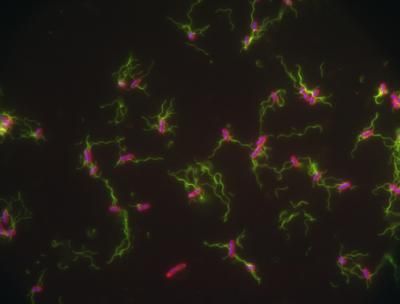Pitt team finds molecule that regulates heart size by using zebrafish screening model
Using zebrafish, researchers at the University of Pittsburgh have identified and described an enzyme inhibitor that allows them to increase the number of cardiac progenitor cells and therefore influence the size of the developing heart. The findings are described in the advance online version of Nature chemical biology.
The zebrafish model has powerful advantages for studying embryonic development, said senior author Michael Tsang, Ph.D., assistant professor, Department of Microbiology and Molecular Genetics, University of Pittsburgh School of Medicine.
"This gives us a better understanding of heart development during the embryonic stage and has implications for adult disease," he noted. "As we try to create treatments that restore normal function to damaged or diseased tissues, it will help us to know the biologic pathways and signals that formed these organs whole and healthy in the first place. This information can be gained by studying developmental biology."
Zebrafish are vertebrate animals whose transparent embryos develop rapidly, are small and easy to handle and, most importantly, grow outside of the mother. In earlier work, Dr. Tsang and his team bred a line of transgenic zebrafish with the gene for green fluorescent protein linked to a key signaling pathway of fibroblast growth factors (FGFs), a family of proteins that are essential in embryonic development.
"The transgenic zebrafish embryos allow us to actually see when a drug or compound influences FGFs because the cells glow green," Dr. Tsang said. "The embryos are like biosensors for FGF signaling, showing us what's happening in real time in living animals."
For the current paper, he and colleagues focused on a small molecule called BCI, which hyperactivated FGF signaling. They then figured out how: BCI blocked the activity of an enzyme called Dusp6, a feedback regulator that would otherwise have tamped down the enhanced FGF signal.
Knowing that, BCI could then be used as a tool to find out what effect Dusp6 inhibition would have on heart development. Zebrafish treated with BCI had a greater number of cardiac progenitor cells and, ultimately, larger hearts, Dr. Tsang said.
Unraveling the fibroblast growth factor pathway has broad implications for improving wound healing as well, Dr. Tsang said. For example, FGF2 has been used in treatment of chronic skin ulcers and following burn surgery in Japan. Thus, BCI alone or in combination with FGF2 might accelerate the healing process and improve wound repair.
Topics
Organizations
Other news from the department science
These products might interest you

Octet R2 / Octet R4 / Octet R8 by Sartorius
Full power on 2, 4 or 8 channels: Label-free and GxP-compliant analysis of molecular interactions
Innovative label-free real-time protein quantification, binding kinetics and rapid screenings

Octet RH16 and RH96 by Sartorius
Efficient protein analysis for process optimisation and manufacturing control in high-throughput
Label-free protein quantification and characterization of protein-protein interactions

Octet SF3 by Sartorius
Surface Plasmon Resonance (SPR) using Single Dynamic Injections for Kinetics and Affinities
Curvature is Key - Adding a ‘Third Dimension’ to the Binding Curve

Get the life science industry in your inbox
By submitting this form you agree that LUMITOS AG will send you the newsletter(s) selected above by email. Your data will not be passed on to third parties. Your data will be stored and processed in accordance with our data protection regulations. LUMITOS may contact you by email for the purpose of advertising or market and opinion surveys. You can revoke your consent at any time without giving reasons to LUMITOS AG, Ernst-Augustin-Str. 2, 12489 Berlin, Germany or by e-mail at revoke@lumitos.com with effect for the future. In addition, each email contains a link to unsubscribe from the corresponding newsletter.



















































